How Hitler Could Have Won World War II (43 page)

Shirer, William L. The Rise and Fall of the Third Reich. New York: Simon & Schuster, 1960.
Shulman, Milton.
Defeat in the West.
London: Secker & Warburg, 1986.
Spears, Sir Edward L. Assignment to Catastrophe: Prelude to Dunkirk, The Fall of France. New York: A. A. Wyn, 1955.
Speer, Albert.
Inside the Third Reich.
London: Macmillan, 1970.
Stewart, I. M. G.
The Struggle for Crete.
London: 1955.
Streit, Christian.
Keine Kameraden. Die Wehrmacht und die sowjetischen Kriegsgefangenen
1941â1945.
Stuttgart: Deutsche Verlags-Anstalt, 1978.
Sydnor, Charles.
Soldiers of Destruction: The SS Death's Head Division 1933â1945.
Princeton, N.J.: 1977.
Tarrant, V. E. Stalingrad. London: Leo Cooper, 1992.
Taylor, A. J. P. The Origins of the Second World War. London: 1963.
Tedder, Marshal Lord.
With Prejudice.
Boston: Little, Brown, 1967; London: Cassell, 1966.
Terkel, Studs.
The “Good War”: An Oral History of World War Two.
New York: Pantheon, 1984.
Trevor-Roper, H. R.
Hitler's War Directives, 1939â1945.
London: Sedgwick, 1964.
âââ.
The Last Days of Hitler.
London: Collier, 1971.
Ueberschär, Gerd R., and Wolfram Wette, eds.
Unternehmen Barbarossa.
Paderborn: Ferdinand Schöningh, 1984.
Warlimont, Walter.
Inside Hitler's Headquarters.
San Rafael, Calif.: Presidio, 1994. 1962.
Webster, Sir Charles, and Noble Frankland.
The Strategic Air Offensive Against Germany
1939â1945,
vol. 1;
Preparation,
vol. 2;
Endeavour,
vol. 3;
Victory,
vol. 4. London: HMSO, 1961.
Westphal, Gen. Siegfried.
The German Army in the West.
London: Cassell, 1951. Willmott, H. P. The Great Crusade. New York: Free Press, 1990.
Wilmot, Chester.
The Struggle for Europe.
New York: Harper, 1952.
Young, Desmond.
The Desert Fox.
New York: Harper, 1950.
Zabecki, David T., ed.
World War II in Europe: An Encyclopedia.
2 vols. New York: Garland Publishing, 1999.

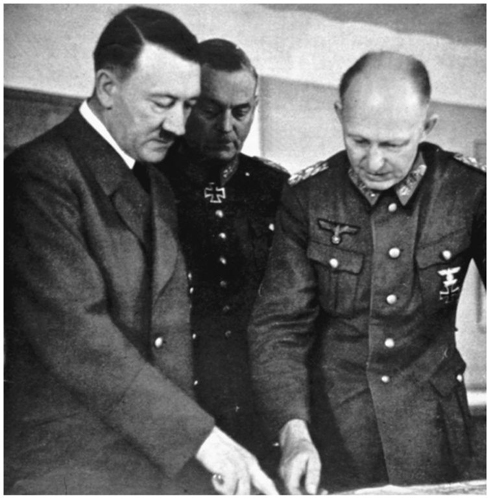
Adolf Hitler
(left)
confers with Field Marshal Wilhelm Keitel and General Alfred Jodl. Keitel was chief of staff of the
Oberkommando der Wehrmacht
(OKW), or armed forces supreme command, while Jodl was OKW chief of operations. Keitel was a toady to Hitler, but Jodl gave Hitler limited advice, though he never dared clash with the Fuehrer.
(Topham/
The Image Works)
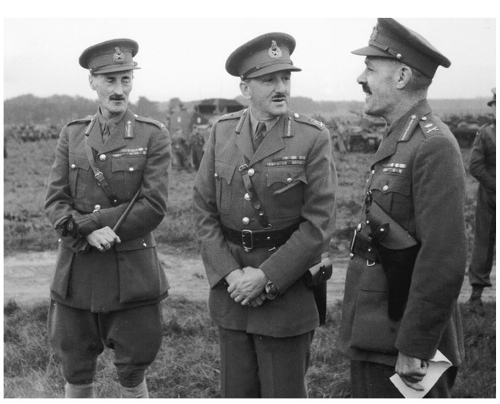
Field Marshal Sir Alan Brooke
(center)
, chief of the British Imperial General Staff, with Lieutenant Generals Laurence Carr (left) and Sir G. le Q. Martel. (Topham/The Image Works)
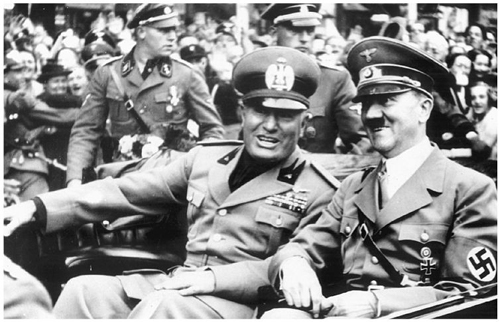
Italian dictator Benito Mussolini
(left)
and Adolf Hitler in a motorcade in Berlin.
(Topham/
The Image Works)
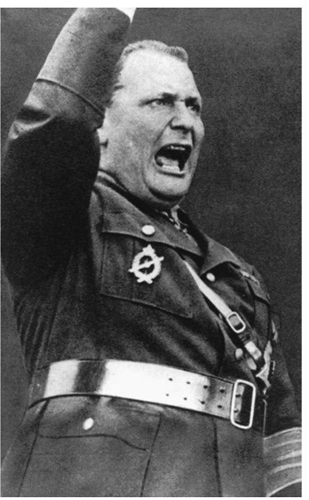
Hermann Göring, chief of the German Luftwaffe, or air force, and a crony of Hitler.
(Topham/The Image
Works)
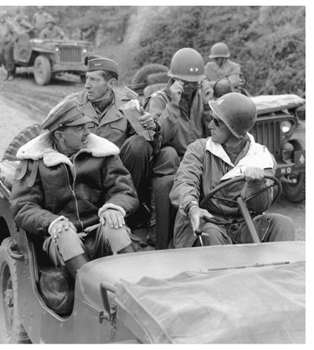
British General Sir Harold Alexander, Allied commander in Tunisia and Italy
(in front seat)
, with American Lieutenant General Mark Clark, 5th Army commander
(in
back seat, left),
and Major General John Coulter.
(Topham/The Image
Works)
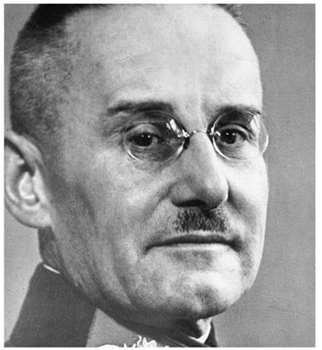
General Franz Halder, chief of staff of the German army since 1938, persisted in pointing out the dangers of dividing German forces between Stalingrad and the Caucasus. Hitler paid no attention and removed him on September 15, 1942.
(AP/Wide World Photo)
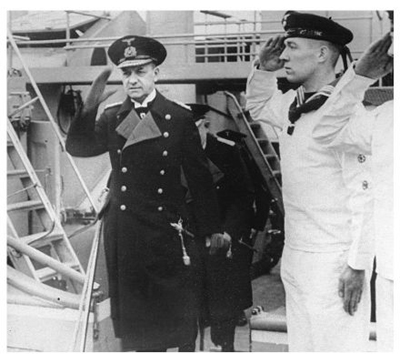
Grand Admiral Erich Raeder
(left),
chief of the German navy, leaves a vessel after an inspection in December 1939. Raeder tried repeatedly to convince Hitler to commit enough German forces to seize Egypt, the Suez Canal, and the Middle East, but Hitler refused and continued with his fixation on destroying the Soviet Union by a direct attack. Hitler removed Raeder early in 1943.
(AP/Wide World Photo)
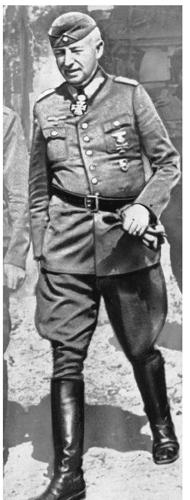
Field Marshal Erich von Manstein conceived the plan that defeated France in six weeks in 1940 and carried out withdrawals that saved the southern wing of the German army in Russia early in 1943 after Hitler's disastrous decision to sacrifice the 6th Army at Stalingrad.
(AP/Wide World Photo)
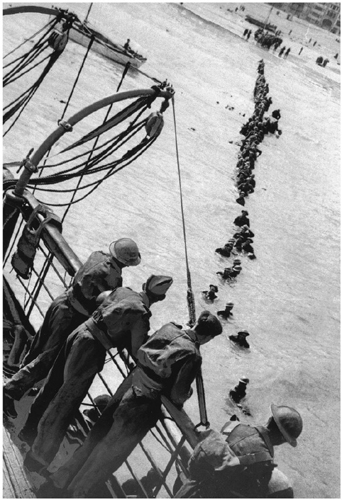
British soldiers form a human chain to wade through the surf during the evacuation of Dunkirk, France, in June 1940. The British mobilized every vessel they could find, from private yachts to warships, to rescue 338,000 beleaguered British and French troops, cut off by the German thrust through the Ardennes to the English Channel.
(AP/Wide World Photo)
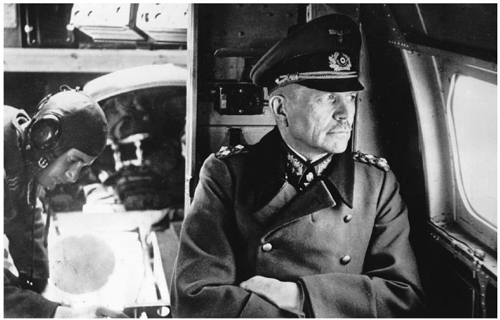
General Heinz Guderian in his command vehicle. Guderian was father of the German panzer, or armored, divisions; he led the breakout through the Ardennes to the English Channel in May 1940 and directed the main panzer thrust at Moscow in the fall of 1941.
(Topham/The Image Works)
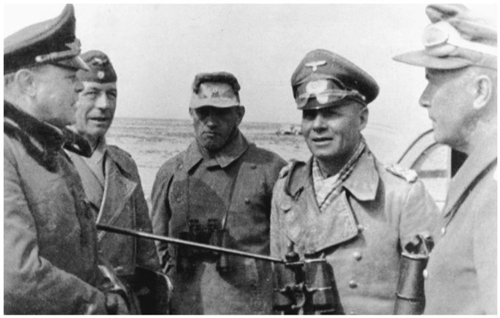
The major German commanders in Africa in 1941
(from left):
Field Marshal Albert Kesselring, German chief in the Mediterranean; Major General Stefan Froehlich, Luftwaffe commander in Africa; Lieutenant General Alfred Gause, Rommel's chief of staff; General Erwin Rommel, field commander; and Lieutenant General Ludwig Cruewell, chief of Africa Corps.
(Topham/
The Image Works)

